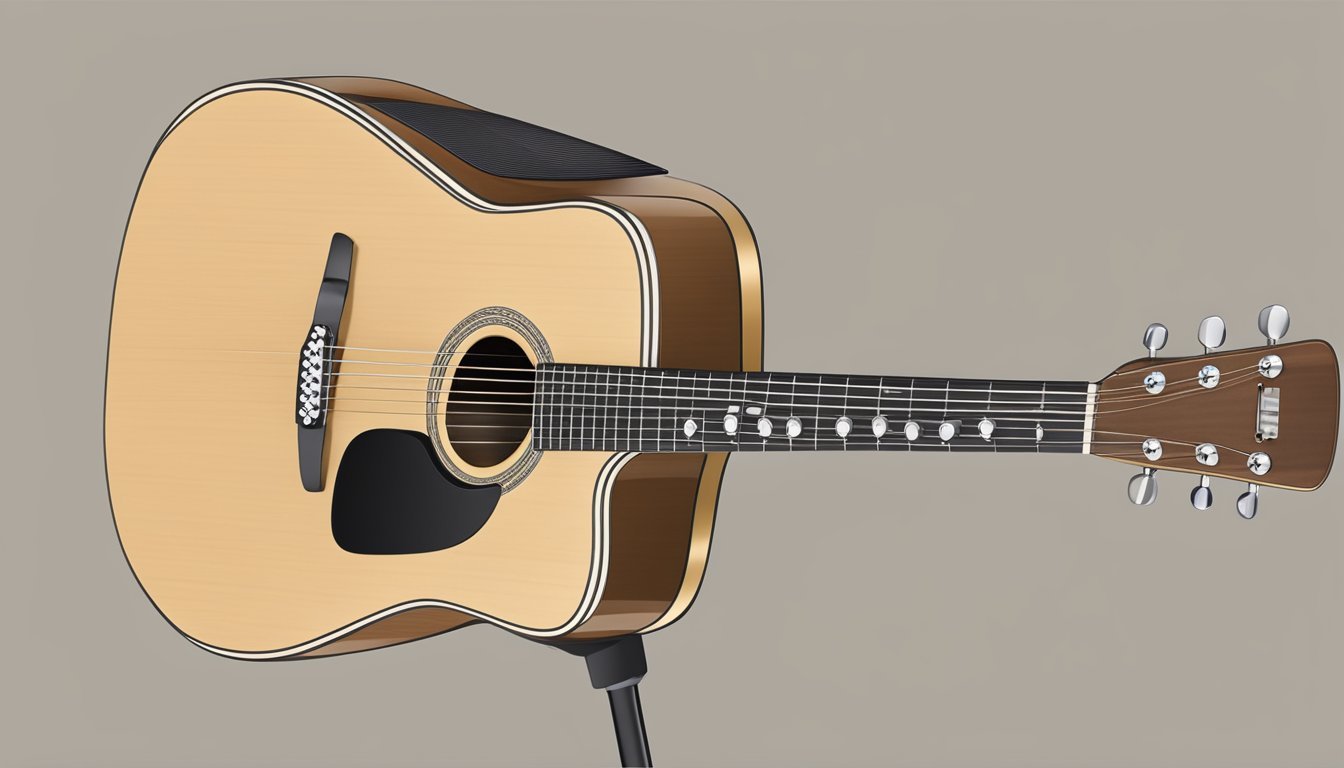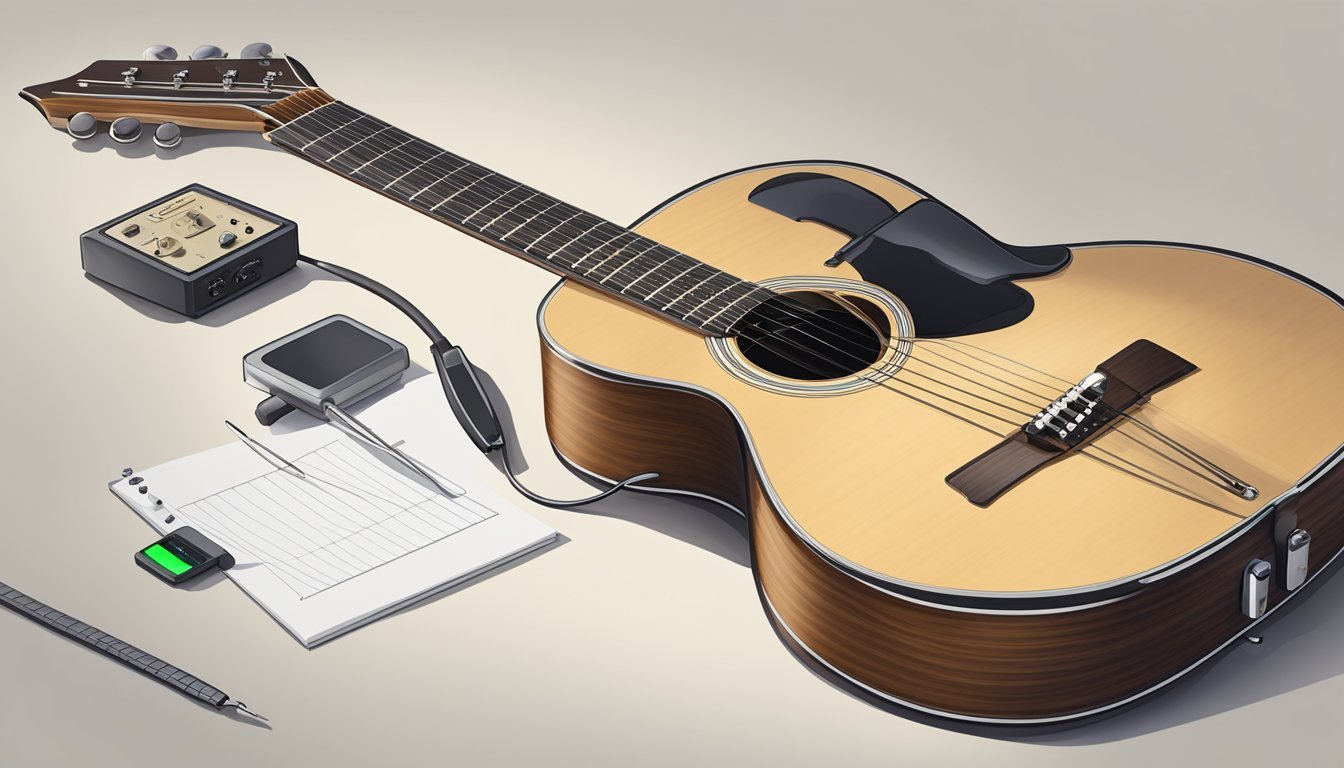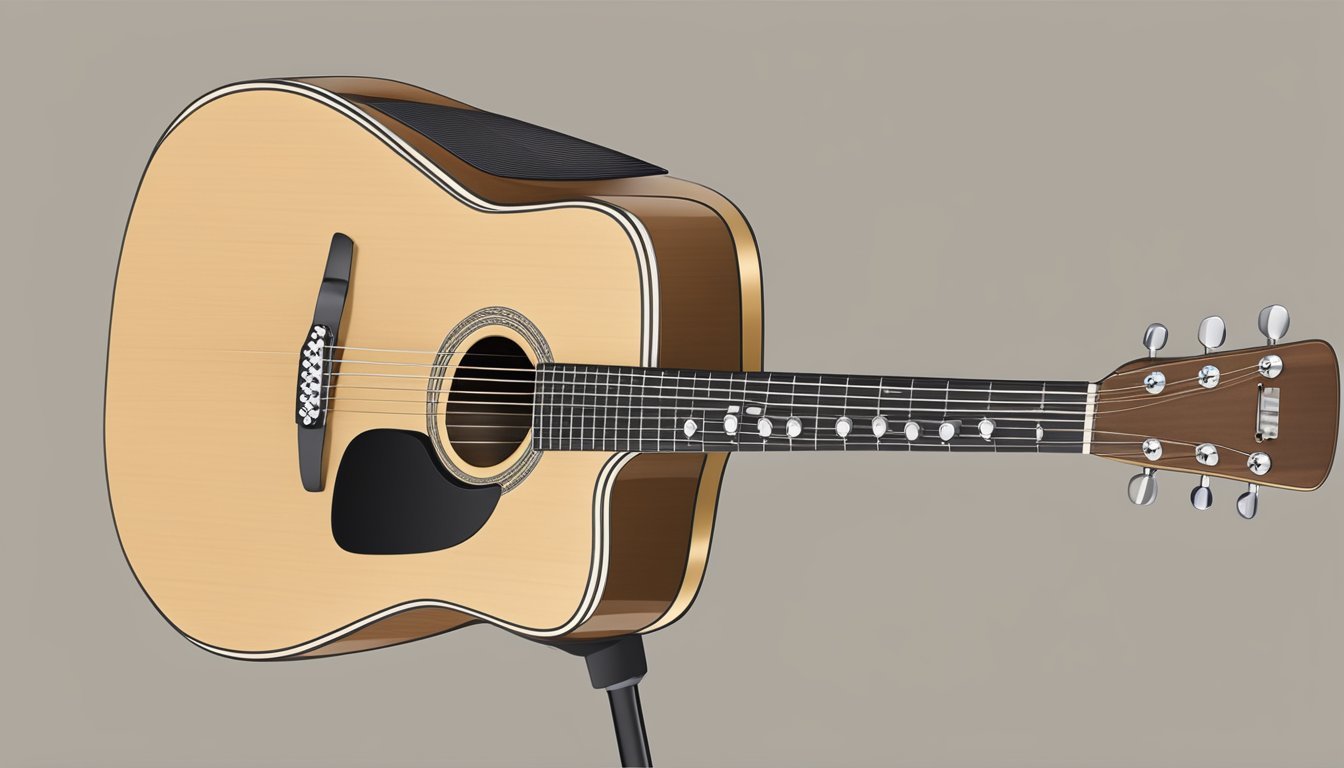Tuning your acoustic guitar can seem tricky, but it doesn’t have to be. A guitar tuner makes it easy to get your instrument sounding just right. Whether you’re a beginner or getting back into playing, having your guitar in tune is essential for a great sound and an enjoyable experience.

With the right tuner and a few simple steps, you can quickly learn how to tune your guitar accurately.
This guide will take you through the process and help you understand how to achieve perfect pitch every time you play.
Get ready to keep your guitar sounding its best!
Key Takeaways
- Choose a guitar tuner that suits your needs for accurate results.
- Learn the basics of standard tuning to get started.
- Regular maintenance helps you avoid common tuning issues.
Choosing the Right Tuner
When it comes to tuning your acoustic guitar, picking the right tuner can make a big difference.
You have options varying from electronic tuners to handy apps.
Here’s what you need to know.
Types of Guitar Tuners
There are several types of guitar tuners to consider.
Most commonly, you’ll find clip-on tuners, which attach to the guitar’s headstock.
They detect vibrations directly from the guitar, making them highly accurate.
Pedal tuners are popular among electric guitar players.
They can handle multiple instruments and provide clear readouts.
If you prefer something more traditional, needle tuners give a visual representation of pitch.
Another option is mobile apps.
These can turn your phone into a tuner using its microphone.
Just be aware that their accuracy may vary.
Each type has its pros and cons, so think about what suits your playing style best.
Tuner Apps vs. Physical Tuners
Choosing between tuner apps and physical tuners can be tricky. Tuner apps are convenient.
You can download a free online guitar tuner right onto your smartphone.
They often come with features like different tuning styles and sounds.
Physical tuners, especially electronic tuners, typically provide more accurate tuning.
They often use a microphone switch that captures sound more effectively than your phone.
This means you’ll get more reliable results, especially in noisy environments.
App tuners are great for casual players, but if you play gigs, investing in a good physical tuner is worth it.
You want your guitar to sound its best without any hassle.
The Basics of Guitar Tuning
Tuning your guitar is one of the first skills you’ll need.
It keeps your music sounding its best.
Understanding standard tuning and how to use a tuner will set you on the right path.
Understanding Standard Tuning
Standard tuning is the most common way to tune your guitar.
The strings are tuned to the following notes from the thickest to the thinnest:
- Low E (6th string)
- A (5th string)
- D (4th string)
- G (3rd string)
- B (2nd string)
- High E (1st string)
Knowing these notes helps you find the right target pitch.
Each string is tuned to make a perfect interval with the others.
This creates a balanced sound, making it easier to play your favorite songs.
How to Use a Tuner
Using an electronic tuner is a simple way to tune your guitar.
First, plug your guitar into the tuner or use a clip-on tuner.
When you pluck a string, the tuner will show you the current pitch.
Adjust the tuning peg:
- Turn clockwise to raise the pitch.
- Turn counterclockwise to lower it.
Aim for the green light or indicator on the tuner.
This means your string is in tune.
Repeat this process for all six strings.
A good tuner will make the task easy, allowing you to focus on playing.
Achieving Perfect Pitch

Getting your guitar in perfect pitch is essential for a great sound.
You can tune your guitar using a tuner or by ear.
Both methods have their benefits, and knowing how to combine them can help you achieve the best sound.
Tuning by Ear
Tuning by ear is a useful skill that many guitarists develop.
To start, tune your A string (the 5th string) to a reference pitch.
You can use a tuning fork, a piano, or even an app on your phone.
Once the A string is set, use it to tune the other strings.
For standard tuning, follow this order:
- 5th string (A): Reference note
- 4th string (D): 5 frets up from A
- 3rd string (G): 5 frets up from D
- 2nd string (B): 4 frets up from G
- 1st string (E): 5 frets up from B
Listen closely to the sound and adjust as needed.
It may take practice, but you’ll get better at detecting string discrepancies over time.
Fine-Tuning Techniques
Fine-tuning is all about making small adjustments to ensure everything sounds just right.
After using your tuner, listen for any notes that seem off.
Play chords and listen carefully to how they blend.
If something sounds out of place, focus on that string.
Use your tuner to check if it’s sharp or flat. Microphone setups can help amplify the sound, making it easier to hear discrepancies.
Remember to stretch the strings slightly after tuning.
This helps them settle in, preventing them from drifting out of tune quickly.
Adjust as needed based on what you hear.
Regular practice will improve your tuning skills and ear for music.
Maintenance and Troubleshooting
Keeping your acoustic guitar in top shape is key to maintaining a well-tuned instrument.
Regular checks and care can prevent issues like string buzz and tuning problems caused by environmental changes.
Dealing with String Buzz
If you’re experiencing string buzz, it can be frustrating.
This often occurs when guitar strings vibrate against the frets.
Common causes include low frets or worn-out strings.
To fix this, check your tuning pegs first.
Tightening them can sometimes eliminate buzz.
If the strings are old, consider replacing them for a cleaner sound.
Steps to Troubleshoot String Buzz:
- Inspect the frets: Look for any unevenness.
- Check the neck relief: Adjust the truss rod if needed.
- String height: Adjust bridge height to raise or lower strings.
If these steps fail, a visit to a guitar technician may be necessary.
Effects of Temperature and Humidity
Temperature and humidity can seriously impact your guitar’s performance.
Wood expands and contracts with changes in these factors, affecting tuning stability and sound.
Keep your guitar in a stable environment.
Aim for a humidity level around 45-55%.
Too much moisture leads to warping, while too little causes cracks.
Tips for Maintaining Optimal Conditions:
- Use a hygrometer to measure humidity.
- Store your guitar in a case with a humidifier if needed.
- Avoid direct sunlight or extreme temperatures.
By being mindful of these elements, you can help sustain your guitar’s sound quality and ensure it stays in tune.
Frequently Asked Questions
When you’re ready to tune your acoustic guitar, you might have a lot of questions.
Let’s cover some common ones that can help you get started and improve your tuning skills.
One of the first things to understand is the difference between tuning an acoustic and an electric guitar, as the latter often requires different techniques or tools.
For those curious about how to tune an electric guitar, using a digital tuner can make the process simpler and more precise.
Additionally, it’s helpful to familiarize yourself with the standard tuning notes and consider using a reference pitch to ensure accuracy in your tuning.
What’s the right way to tune an acoustic guitar for a total newbie?
To tune your acoustic guitar, start by turning on your tuner.
Pluck the sixth string, which is the low E, and watch the tuner.
Adjust the tuning peg until the tuner shows that the string is in tune.
Can I tune my acoustic guitar without using a tuner, or is a tuner a must-have?
You can tune your guitar by ear, but it might take more practice.
Using a tuner is easier and helps you get accurate pitches quickly.
If you’re a beginner, a tuner can save you time and frustration.
What are the standard tuning notes I should aim for with my acoustic guitar strings?
The standard tuning notes for an acoustic guitar are E, A, D, G, B, and E, from the sixth string to the first string.
This tuning is often called EADGBE.
It’s the foundation for many songs and chords.
Are there any tips for using a tuner to get my acoustic guitar sounding perfect?
Make sure the tuner is on and calibrated correctly.
Pluck each string gently and adjust the tuning peg slowly.
It’s best to tune up to the note rather than down to avoid slipping.
What’s the best method for tuning an acoustic guitar using a tuner app?
If you’re using a tuner app, open it and place your phone near the guitar.
Play each string one at a time and follow the app’s guidance.
Make small adjustments to the tuning pegs as needed.
Should I start tuning an acoustic guitar with a certain string?
You can start with the low E string because it’s the thickest.
Some players prefer to begin with the A string since it helps set a good foundation for the rest.
Choose whichever string you feel most comfortable with.

